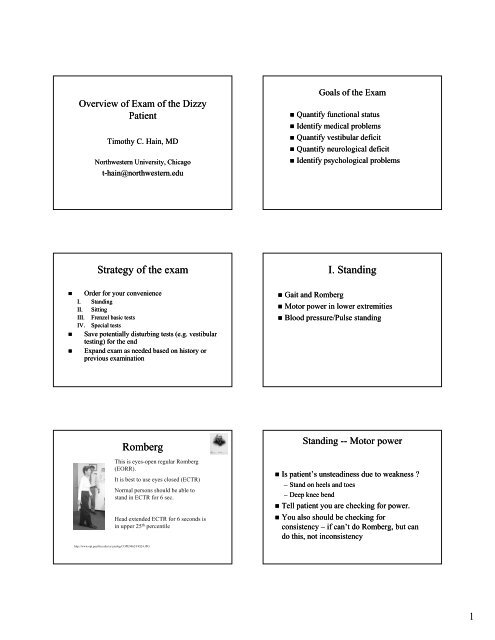neuro-otologic exam 2008.pdf - Tchain.com
neuro-otologic exam 2008.pdf - Tchain.com
neuro-otologic exam 2008.pdf - Tchain.com
Create successful ePaper yourself
Turn your PDF publications into a flip-book with our unique Google optimized e-Paper software.
Overview of Exam of the Dizzy<br />
Patient<br />
Timothy C. Hain, MD<br />
Northwestern University, Chicago<br />
t-hain@northwestern.edu<br />
Goals of the Exam<br />
• Quantify functional status<br />
• Identify medical problems<br />
• Quantify vestibular deficit<br />
• Quantify <strong>neuro</strong>logical deficit<br />
• Identify psychological problems<br />
Strategy of the <strong>exam</strong><br />
I. Standing<br />
• Order for your convenience<br />
I. Standing<br />
II.<br />
Sitting<br />
III. Frenzel basic tests<br />
IV. Special tests<br />
• Save potentially disturbing tests (e.g. vestibular<br />
testing) for the end<br />
• Expand <strong>exam</strong> as needed based on history or<br />
previous <strong>exam</strong>ination<br />
• Gait and Romberg<br />
• Motor power in lower extremities<br />
• Blood pressure/Pulse standing<br />
Romberg<br />
This is eyes-open regular Romberg<br />
(EORR).<br />
It is best to use eyes closed (ECTR)<br />
Normal persons should be able to<br />
stand in ECTR for 6 sec.<br />
Head extended ECTR for 6 seconds is<br />
in upper 25 th percentile<br />
Standing -- Motor power<br />
• Is patient’s unsteadiness due to weakness ?<br />
– Stand on heels and toes<br />
– Deep knee bend<br />
• Tell patient you are checking for power.<br />
• You also should be checking for<br />
consistency – if can’t do Romberg, but can<br />
do this, not inconsistency<br />
http://www.opt.pacificu.edu/ce/catalog/COPE9462/FIG24.JPG<br />
1
Standing -- Blood pressure/Pulse<br />
II. Sitting <strong>exam</strong> (without goggles)<br />
• Measure BP/pulse<br />
• Cranial Nerve <strong>exam</strong><br />
• Upper ext. Neurological, DTR, Toe signs<br />
• Vibration at Ankle<br />
II. Essential Cranial Nerves<br />
• Vision<br />
• Oculomotor<br />
• Hearing<br />
II. Vision<br />
• Visual acuity<br />
– Is patient (nearly) blind<br />
?<br />
– Can patient see with<br />
both eyes ?<br />
• Does the patient have a<br />
VOR ?<br />
8 th nerve: Dynamic Illegible ‘E’<br />
test( DIE test)<br />
Rapid Dolls<br />
Head Impulse Test (HIT)<br />
• Distance vision with head<br />
still<br />
• Distance vision with head<br />
moving<br />
• Normal: 0-2 logmar<br />
change.<br />
• Abnormal: 4-7 logmar<br />
change<br />
http://www.dizziness-and-balance.<strong>com</strong>/practice/dynvisual.html<br />
2
Ophthalmoscope Test<br />
II. Oculomotor<br />
Does patient have double vision, nystagmus ?<br />
Can patient track ?<br />
• Range, alignment and<br />
Gaze<br />
• Saccades<br />
• Pursuit<br />
II. Gaze Testing<br />
• Move finger to the limits of lateral gaze<br />
(bury sclera) – if can’t bury, may have<br />
oculomotor palsy<br />
• Move finger to limits of vertical gaze<br />
• Do eyes reach end-gaze ?<br />
• Is there end-gaze nystagmus ?<br />
• Alexander's Law<br />
Gaze nystagmus<br />
II. Hearing -- 8 th nerve<br />
• Screen Hearing<br />
– Rubbed fingers (high frequencies)<br />
– Tuning forks (Good but slow)<br />
• Deep tendon reflexes<br />
• Babinski sign<br />
• Tremor<br />
• Tone<br />
Motor<br />
3
Coordination<br />
Sensory Examination<br />
• Finger to nose (FTN),<br />
fine finger movements<br />
• Rapid alternating<br />
movements (RAM)<br />
• Vibration sense (ankles)<br />
III. Frenzel Goggles<br />
Optical Frenzel Goggles<br />
C/o Micromedical Technology, Chatham IL<br />
• Inexpensive (about $500)<br />
• Portable – take on the road<br />
• A little limited – can’t do vibration, head-forward<br />
or cross-cover<br />
cover<br />
• Can get hot, bulbs burn out and break<br />
Frenzel – routine test<br />
Spontaneous Nystagmus Test<br />
• Observe nystagmus in<br />
light and dark<br />
– Acute vestibular<br />
disorders have strong<br />
horizontal “jerk”<br />
nystagmus.<br />
• Many other types of<br />
nystagmus<br />
• Method: Apply 60-120 hz<br />
vibration to SCM, first<br />
one side, then the other.<br />
Shower massagers work<br />
well for this and are<br />
inexpensive.<br />
• Video Frenzel goggles –<br />
optical Frenzels don’t<br />
work very well<br />
• Compare nystagmus<br />
before and during<br />
Frenzel -- Routine<br />
Vibration<br />
4
Vibration Induced Nystagmus<br />
• Unidirectional horizontal nystagmus<br />
strongly suggests contralateral vestibular<br />
lesion.<br />
• Vertebral artery test<br />
(VAT) for cervical<br />
vertigo<br />
• Dix-Hallpike<br />
testing<br />
– For BPPV<br />
• Situational testing<br />
– Lateral canal<br />
Frenzel -- Routine<br />
Positional Testing<br />
IV Frenzel – Situational<br />
Head-shaking test<br />
• Method: 20 cycles of<br />
horizontal head rotation<br />
• Frenzel goggles to<br />
monitor nystagmus prior<br />
to and following head-<br />
shaking.<br />
• Positive – substantial<br />
change in nystagmus<br />
following head-shaking.<br />
Usually beats away from<br />
bad ear.<br />
IV Frenzel Situational Tests<br />
Pressure sensitivity<br />
• Valsalva test<br />
– 10 seconds of exhale<br />
against closed glottis<br />
(to increase CSF<br />
pressure)<br />
– Sensitive<br />
• Tullio test<br />
– Brief loud noise<br />
– Insensitive<br />
IV Frenzel Situational Tests:<br />
Hyperventilation<br />
• 30 seconds of brisk<br />
HVT<br />
• Exam for change in<br />
nystagmus<br />
– Irritable vestibular<br />
nerve<br />
– Seizure (very rare)<br />
– Anxiety (dizzy, no<br />
nystagmus)<br />
More details<br />
Hain, T.C. Approach to the patient<br />
with Dizziness and Vertigo. Practical<br />
Neurology (Ed. Biller), 2002, 2007.<br />
Lippincott-Raven<br />
i More movies<br />
www.dizziness-and-balance.<strong>com</strong><br />
5







